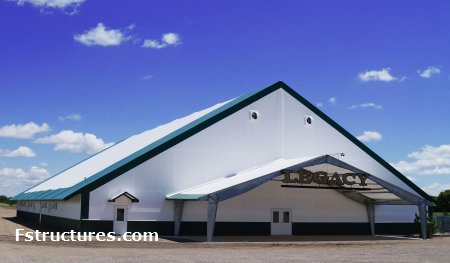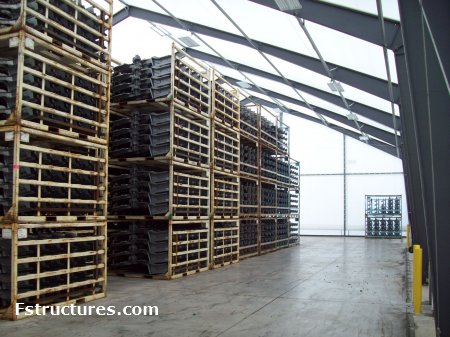Fabric structures on a rigid steel frame are ideal for a variety of surface mining applications. Fabric buildings are flexible and sturdy enough to be used in all phases of the mining process.
Â
Fabric buildings are designed to be permanent but can be relocated, expanded or reduced as needed. Each building is low-maintenance and corrosion-resistant. The fabric cladding will never corrode, and steel frames can be painted, primed or hot dip galvanized for ultimate corrosion protection.
Â
Each aspect of a fabric structure is completely customizable – widths over 300 feet wide, any length, and peak and side wall clearances set where you need them. Any type of vehicle or equipment will have room to maneuver inside the custom structure. Hanging loads such as cranes, conveyors and fire suppression systems can be added right to the building frame for increased functionality.
Â
Customization doesn’t end with building size. The solid steel frame can support accessories including large or multiple doors, ventilation systems or various end wall configurations. Design build structures can be created to fit on odd-shaped lots, or add a canopy to connect a new building with existing building systems.
Â
For even more flexibility, fabric can be combined with other building materials such as steel or concrete walls, or fiber-reinforced polymer (FRP). Hybrid fabric buildings are especially popular for bulk storage.
Â
Customization isn’t the only benefit of fabric buildings. With the strength of a rigid steel frame, Legacy buildings can withstand any environmental conditions. Each structure is design-built for applicable snow load, wind load and seismic load at the job site. Each building is designed to carry multiple loads, including environmental loads and drop loads from cranes and conveyors.
Â
Lightweight architectural fabric can be shipped anywhere in the world more cheaply than steel cladding. Once onsite, your fabric building can be constructed more quickly than traditional building types, allowing for earlier occupancy and profit.
Â
Of course, the most common advantage of fabric buildings is the naturally bright interior. On a sunny day, light penetrates a fabric building through the walls and ceiling, creating a well-lit, pleasant work environment and saving on artificial lighting costs. For night work and overcast days, interior lighting will be magnified – allowing for less electricity used in lighting.
Â
Any feature of a traditional building can be incorporated into a fabric building. Add a lean-to for additional storage or covered parking, build a structure tall enough for a crane to operate inside, use open end walls to drive in and out with maximum maneuverability. It’s all possible inside a fabric structure.
Â
With all the benefits of fabric buildings, it’s no wonder they are popular for mining applications. Below are just some of the ways fabric structures are used in mining.
Â
EXPLORATION COVERED BUILDING
  ·    Staging facilities
  ·    Portable structures for directional drilling
  ·    Remote mine site shops
Â
PROCESSING COVERED STRUCTURE
  ·    Surge pile covers
  ·    Transfer storage facilities
  ·    Process and bulk storage
  ·    Infrastructure weather protection
  ·    Sorting and packaging
Â
OPERATIONS BUILDINGS
  ·    Workshops
  ·    Garages
  ·    Maintenance facilities
Â
TENSION FABRIC MEMBRANE WAREHOUSE
  ·    Break bulk storage
  ·    Cold storage warehousing
  ·    Manufacturing overflow buildings
      Palletized storage
Â
New technology gives fabric buildings the strength and flexibility of traditional building types along with decreased construction time and a better interior work environment. With custom engineering and design-build capabilities, a fabric building can be created for any mining application.Â






